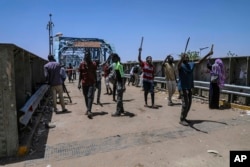Sudan's protest leaders and the Transitional Military Council have agreed on the main structure of a transitional government, a significant step forward in the weeks-long stand-off between the two sides. But they are yet to agree on the side that will have a majority in a new, transitional ruling council until the 2022 elections.
Protesters on Wednesday greeted the late-night deal with a mixture of hope and skepticism when the opposition Declaration of Freedom and Change Forces (DFCF) and Transitional Military Council made the announcement late Tuesday.
The two sides split the difference on a timeline for Sudan's elections between the opposition's demand for a four-year transition and the military's wanting two years.
The power-sharing agreement includes three councils to run sovereign, ministries, and legislative body. The DFCF would hold two-thirds of the seats in the 300-seat parliament.
But there is no agreement yet on which side -— civilian or the military — will have a majority in the ruling sovereign council until elections in 2022.
Ruaa Obaid said she and fellow protesters are still waiting for an announcement on a final agreement, expected Wednesday night.
She said the agreement announced Tuesday was satisfying to some extent as it's a good idea. But her hope is that things will progress further. She said protesters are awaiting the results and hope it'll be satisfying for everyone.
The deal is the most significant step forward in Sudan's weeks-long stand-off between thousands of protesters demanding civilian rule and the military.
An attack on the protesters' sit-in around the Defense Ministry on Monday night left at least six people dead, dozens injured, and raised fears the talks might fall apart.
But protest leaders and the military were quick to say negotiations would continue and announced late Tuesday that a committee was set up to investigate the attack.
Nonetheless, protesters reinforced steel and rock walls around the sit-in, which started April 6 to demand former president Omar al-Bashir step down.
Even after the military ousted Bashir on April 11 from three decades in power, protests continued for civilian rule.
Sitting in a chair near newly-erected barricades, protester Othman Karrar warned a compromise with the military might not satisfy everyone.
He said people in the sit-in area, people are insisting on their full demands and that any compromise would be apportioning the power of the revolution.
He said his observation is that those young people won't easily back down.
The first six months of the agreed transition are to be dedicated to seeking peace in areas of conflict in Sudan, such as war-torn Darfur, South Kordofan and the Blue Nile
Millions of people in Sudan have been affected by the conflicts and hundreds of thousands displaced.
Fighting erupted again in 2015 as Bashir's forces tried to regain control of rebel-held territory three months before April elections.
Bashir is wanted by the International Criminal Court for alleged war crimes and genocide in Darfur, but the military has refused to hand him over.









